Nationality American Weight 163 kg Height 1.73 m | Role Olympic athlete Name Paul Anderson | |
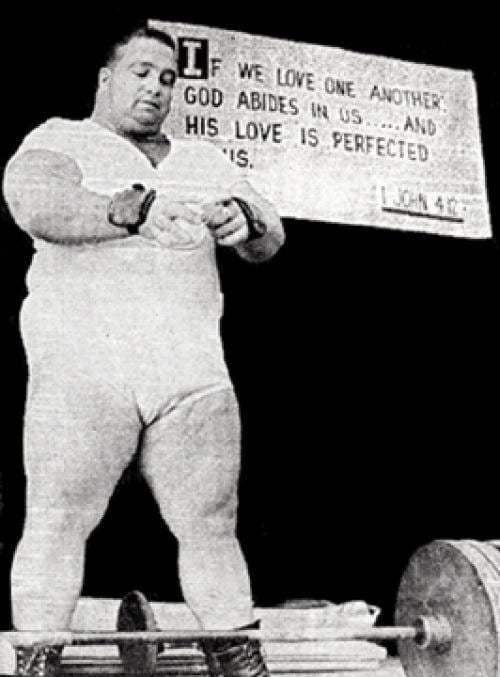 | ||
Born October 17, 1932 ( 1932-10-17 ) Toccoa , Georgia, USA Olympic medals Weightlifting at the 1956 Summer Olympics - Men's Heavyweight +90 kg Similar People | ||
Paul anderson the strongest man in recorded history
Paul Edward Anderson (October 17, 1932 – August 15, 1994) was an American weightlifter, strongman and powerlifter. He was an Olympic gold medalist and a World Champion and two-time National Champion in Olympic weightlifting. Anderson played a big part in the manifestation of powerlifting as a competitive sport. He is considered to be one of the strongest men in recorded history for his mostly unbeaten feats of strength.
Contents
- Paul anderson the strongest man in recorded history
- Early life
- Career
- Personal life
- Death
- Legacy
- Official records
- Unofficial lifts
- Quotes about Anderson
- References
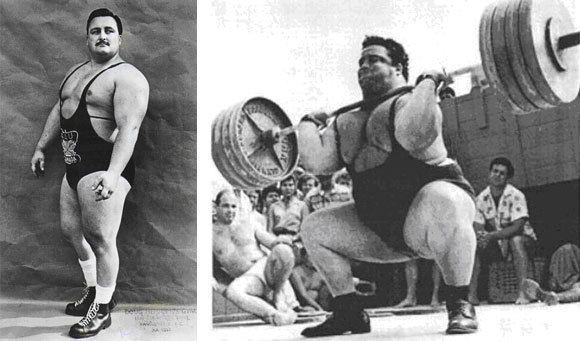
Early life
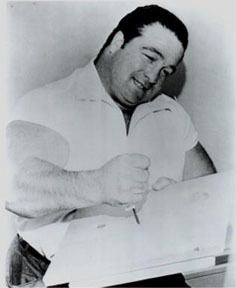
Anderson was born in Toccoa, Georgia, the only son of Ethel Bennett and Robert Anderson. As a teenager, he began his early weight training on his own in his family's backyard to increase his size and strength so that he would be able to play on the Toccoa High School football team, where he earned a position as first-team blocking back. He used special homemade weights that his father created out of concrete poured into a wooden form. Anderson later attended Furman University for one year on a football scholarship before moving to Elizabethton, Tennessee with his parents. There he met weightlifter Bob Peoples, who would greatly influence him in squat training and introduce him into weightlifting circles.
Career
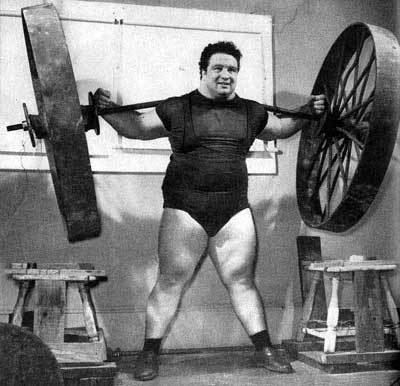
In 1955, at the height of the Cold War, Anderson, as winner of the USA National Amateur Athletic Union Weightlifting Championship, traveled to the Soviet Union, where weightlifting was a popular sport, for an international weightlifting competition. In a newsreel of the event shown in the United States the narrator, Bud Palmer, commented as follows: "Then, up to the bar stepped a great ball of a man, Paul Anderson." Palmer said, "The Russians snickered as Anderson gripped the bar which was set at 402.5 pounds, an unheard-of lift. But their snickers quickly changed to awe and all-out cheers as up went the bar and Anderson lifted the heaviest weight overhead of any human in history." "We rarely have such weights lifted," said the solemn Russian announcer as Anderson hoisted 402.41 lb (182.53 kg). in the two-hand press. Prior to Anderson's lift, the Soviet champion, Alexey Medvedev, had matched the Olympic record of the time with a 330.5 lb (149.9 kg) press. Anderson then did a 402.5 lb (182.6 kg) press. At a time when Americans were engaged in symbolic Cold War battle with the Soviet Union, Anderson's strength—and his singular, tank-like appearance became a rallying cry to all.
During the 1955 World Championships in Munich, Germany that October, Anderson went on to establish two other world records (for the press - 407.7 lb or 184.9 kg - and total weight cleared - 1,129.5 lb or 512.3 kg) as he easily won the competition in his weight class to become world champion. Upon his return to the United States, Anderson was received by then Vice-President Richard Nixon, who thanked him for being such a wonderful goodwill ambassador.
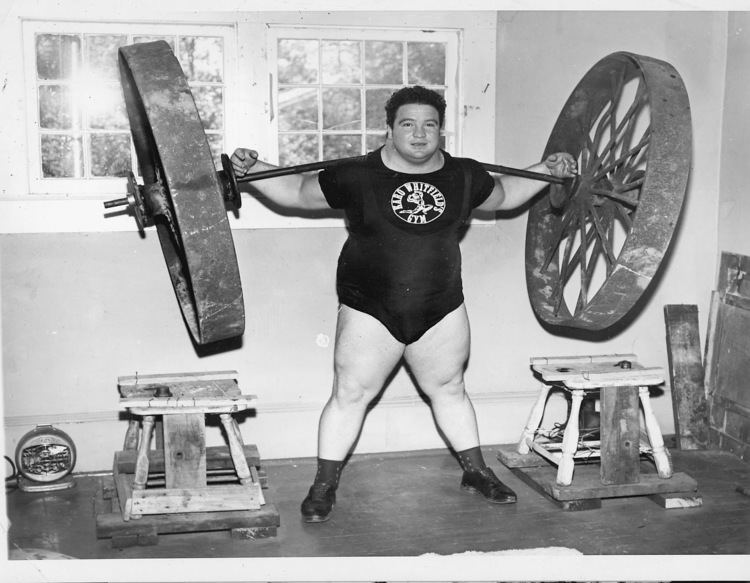
In 1956, Anderson won a gold medal in a long, tough duel in the Melbourne, Australia Olympic Games as a weightlifter in the super-heavyweight class (while suffering from a 104 °F or 40 °C fever) with Argentine Humberto Selvetti in the amount of weight lifted, but because Anderson weighed in at 137.9 kilograms (304 lbs), was lighter than Selvetti, who weighed 143.5 kilograms (316 lbs), Anderson was awarded the gold medal.
Anderson could not compete in the 1960 Olympics because he had been ruled a professional for accepting money for some of his weight lifting and strength exhibitions. Thus at the 1960 Olympics the Soviet heavyweight Yury Vlasov bested records set at the 1956 Olympics, with Anderson not competing in the contest. A short time later however, not to be outdone by the Russian and to verify his position as the World's Strongest Man, Anderson lifted the same weight as the Russian three times in quick succession demonstrating unbelievable strength. The extraordinary American athlete that Anderson was solidified his position as the most dominant lifter in the world and cemented his legacy as the strongest of the strong.
In 1961, Anderson and his wife Glenda founded the Paul Anderson Youth Home, a home for troubled youth in Vidalia, Georgia. They both helped to build and support the Home with an average of 500 speaking engagements and strength exhibitions per year—notwithstanding the chronic congenital kidney disease that eventually killed him at age 61. He would perform stunts such as hammering a nail with his bare fist and raising a table loaded with eight men onto his back.
The Guinness Book of World Records (1985 edition) lists his feat of lifting 6,270 pounds (2844.02 kg) in a back lift as "the greatest weight ever raised by a human being". Anderson turned professional after the 1956 Summer Olympics, and so many of his feats of strength, while generally credible, were not done under rigorous enough conditions to be official. Nevertheless, Guinness Book of World Records did cite him in its 1985 edition for a backlift of 6,270 pounds. This became the basis for his reputation as the "World's Strongest Man".
Personal life
In 1960, Anderson married Glenda Garland. The couple were devout Christians. They had a daughter named Paula (born 1966).
Death
As a child, Anderson suffered from Bright's Disease (now known as chronic nephritis), a kidney disorder, and he eventually died from kidney disease. While competing, he weighed between 275–370 lb (125–168 kg) and was 5 feet 9.5 inches (1.765 m) tall.
Legacy
Anderson's true life testimony can be heard as a dramatization through the Unshackled! radio ministries on program number 2521. Unshackled! has also produced a comic booklet telling the story of Anderson.
Big A Road in Toccoa, Georgia is named for Anderson. Paul Anderson Memorial Park, which features a large statue of him performing an overhead barbell lift, located at the corner of Tugalo Street and Big A Road in Toccoa, is also named for him.
Official records
Olympic weightlifiting
Done in official competition
Unofficial lifts
Lift included in the Guinness Book of World Records This record has been expunged due to no official witness being present, and no evidence of the weight's measurement. (Source: "Guinness Book of World Records".)
Powerlifting
Guinness also listed Anderson's best powerlifts
Done in small exhibitions or training (according to Anderson himself)
Olympic weightlifting
Best gym lifts (according to Anderson himself)
Other lifts
Done in small exhibitions or training
